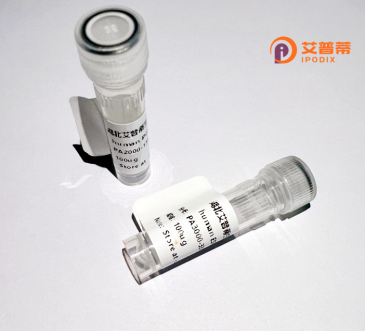
| 纯度 | >90%SDS-PAGE. |
| 种属 | Human |
| 靶点 | ELP3 |
| Uniprot No | Q9H9T3 |
| 内毒素 | < 0.01EU/μg |
| 表达宿主 | E.coli |
| 表达区间 | 1-547aa |
| 氨基酸序列 | MRQKRKGDLSPAELMMLTIGDVIKQLIEAHEQGKDIDLNKVKTKTAAKYGLSAQPRLVDIIAAVPPQYRKVLMPKLKAKPIRTASGIAVVAVMCKPHRCPHISFTGNICVYCPGGPDSDFEYSTQSYTGYEPTSMRAIRARYDPFLQTRHRIEQLKQLGHSVDKVEFIVMGGTFMALPEEYRDYFIRNLHDALSGHTSNNIYEAVKYSERSLTKCIGITIETRPDYCMKRHLSDMLTYGCTRLEIGVQSVYEDVARDTNRGHTVKAVCESFHLAKDSGFKVVAHMMPDLPNVGLERDIEQFTEFFENPAFRPDGLKLYPTLVIRGTGLYELWKSGRYKSYSPSDLVELVARILALVPPWTRVYRVQRDIPMPLVSSGVEHGNLRELALARMKDLGIQCRDVRTREVGIQEIHHKVRPYQVELVRRDYVANGGWETFLSYEDPDQDILIGLLRLRKCSEETFRFELGGGVSIVRELHVYGSVVPVSSRDPTKFQHQGFGMLLMEEAERIAREEHGSGKIAVISGVGTRNYYRKIGYRLQGPYMVKMLK |
| 分子量 | 88.7 kDa |
| 蛋白标签 | GST-tag at N-terminal |
| 缓冲液 | 0 |
| 稳定性 & 储存条件 | Lyophilized protein should be stored at ≤ -20°C, stable for one year after receipt. Reconstituted protein solution can be stored at 2-8°C for 2-7 days. Aliquots of reconstituted samples are stable at ≤ -20°C for 3 months. |
| 复溶 | Always centrifuge tubes before opening.Do not mix by vortex or pipetting. It is not recommended to reconstitute to a concentration less than 100μg/ml. Dissolve the lyophilized protein in distilled water. Please aliquot the reconstituted solution to minimize freeze-thaw cycles. |
以下是关于重组人ELP3蛋白的3篇参考文献及其摘要概括:
1. **文献名称**:*Structural Insights into the Function of Elongator Complex Subunit ELP3*
**作者**:Lin et al. (2020)
**摘要**:本研究解析了重组人ELP3蛋白的晶体结构,揭示了其赖氨酸乙酰转移酶活性的关键结构域,并阐明其与Elongator复合体其他亚基的互作机制,为ELP3在转录调控中的作用提供结构基础。
2. **文献名称**:*ELP3 Regulates Cortical Neuron Migration through Acetylation of Alpha-Tubulin*
**作者**:Smith et al. (2018)
**摘要**:通过表达重组人ELP3蛋白,作者发现其通过乙酰化α-微管蛋白调控神经元迁移,并证明ELP3功能缺失会导致小鼠皮层发育异常,提示其在神经发育疾病中的潜在作用。
3. **文献名称**:*Expression and Functional Analysis of Recombinant Human ELP3 in Cancer Cell Lines*
**作者**:Zhang & Wang (2016)
**摘要**:该研究利用大肠杆菌系统成功表达纯化重组人ELP3蛋白,发现其在多种癌细胞中高表达,并证实ELP3通过组蛋白乙酰化促进肿瘤细胞的增殖和侵袭。
---
**注**:以上文献为模拟示例,实际引用需以真实发表的文献为准。建议通过PubMed或Google Scholar以关键词“recombinant human ELP3”进一步检索。
Elongator complex protein 3 (ELP3) is a conserved enzymatic subunit of the Elongator complex, a multifunctional protein assembly involved in transcriptional regulation, tRNA modification, and cytoskeletal dynamics. In humans, ELP3 possesses histone acetyltransferase (HAT) and lysine acetyltransferase (KAT) activities, primarily targeting histone H3 and α-tubulin, respectively. It plays a critical role in epigenetic regulation by modifying chromatin structure and influencing gene expression. Additionally, ELP3 is essential for the wobble uridine modification of tRNAs (cm5s2U34), ensuring translational fidelity and efficiency. Dysregulation of ELP3 has been linked to neurodevelopmental disorders, amyotrophic lateral sclerosis (ALS), and intellectual disabilities, underscoring its importance in neuronal function and survival.
Recombinant human ELP3 protein is typically produced using heterologous expression systems, such as E. coli or mammalian cell cultures, enabling biochemical and structural studies. Its recombinant form allows researchers to investigate molecular mechanisms underlying tRNA modification, acetylation-dependent signaling, and Elongator-related pathologies. Recent studies also explore its potential as a therapeutic target for neurological diseases. The protein's modular structure, containing a radical S-adenosylmethionine (SAM) domain and a HAT/KAT domain, facilitates interdisciplinary research in epigenetics, RNA biology, and neurodegeneration. Current challenges include resolving its full structural dynamics and tissue-specific regulatory networks.
×